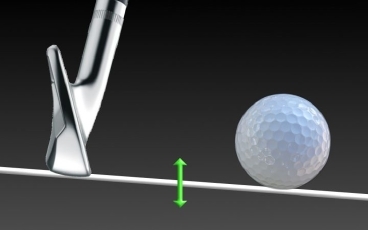The Tiny Golf Swing Change That Can Make Or Break Your Game
Golf tips
We’ve all experienced it – one swing good shot followed by disaster and the swing felt the same. That’s because there is something small in the golf swing that can dramatically affect the outcome – and this article will reveal it.
THE GOOD SHOT
Here we see a club come into impact on a 6 degree angle of attack (represented by the white line) – this is around tour-average for a 7 iron.
You can see the club would effectively strike the ball first, and then contact the ground after (pink star).
THE BAD SHOT
What would happen if, for some reason, the club trajectory were to be just half an inch deeper into the ground?
Let’s take a look…..
Now, in this scenario, the club (incredibly) hits the ground first a whopping 4 inches behind the ball.
We know (from my data collection) that hitting just 2 inches behind a ball can lead to more than a 23% distance loss – and more than a full stroke dropped when compared to a perfect strike (based on stroked gained).
Hitting 4 inches behind – well, that’s just horrible!
NOT 1:1
Think of the trajectory of the clubhead as a big circle around your body (it’s not a perfect circle, but that’s less relevant here).
Shifting the lowest point of the swing circle (the white part of the arc) forwards and backwards (think moving the hula hoop towards/away from the target) will affect the ground in a more or less 1:1 relationship (e.g shift the circle forwards 1 inch and ground contact moves forwards 1 inch).
However, changing the height/depth of the hula hoop (think of dropping it deeper into the ground) has a much more dramatic effect on ground contact.
Depending on a number of variables (such as angle of attack, how tight the lie is etc), it can be closer to an 8:1 relationship – where 0.5 inches of drop in height can change ground contact by 4 inches.
Hence the title of this blog post.
WHAT INFLUENCES ARC HEIGHT?
While we could go through all the moving parts that could potentially change arc height/depth, think of it like this;
Anything that causes the hands to move closer to/farther from the golf ball (in 3D space) at impactthan they were at address will be the biggest determinant of arc height.
For example;
If your lead arm started very straight at address, but returned to impact more flexed – this would influence the height the club comes into impact.
The above table shows many of the elements that relate to arc height control.
ONE PROBLEM
And it’s a biggie….
There are a load of variables in the golf swing which can all contribute to changes in arc height/depth.
And all of these variables are constantly changing – you may even have some variables making your hands get closer to the ball, and at the same time have other variables making your hands get farther from the ball at impact.
It’s the net effect of all of these variables that matters.
Very complex – but there is a solution.
It’s like a game of tug of war between all the variables – hoping to achieve balance
THE SOLUTION
You can make the task of controlling arc height/depth a lot easier by;
- Developing a technique that makes the arc height more consistent through impact
- Some neat drills that allow you to improve your ability to control arc-height on demand
In The Strike Plan, I show you how to do all of the above. The Strike Plan also contains everything you need to know to be able to improve low-point position for pro-quality strikes.
I also show you how to take all that complexity and turn it into simple drills which offer quick but lasting success.






